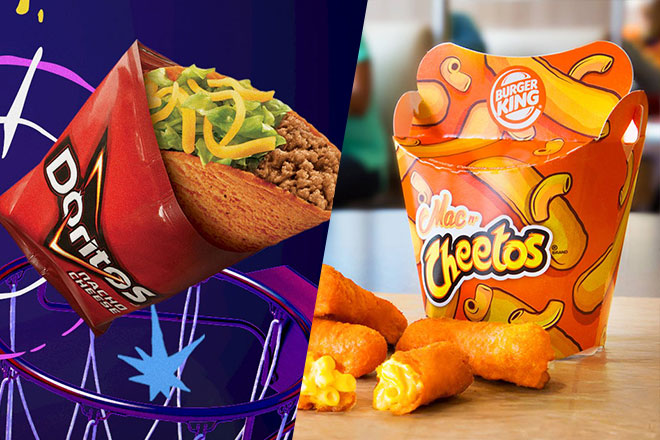The sometimes-scary story of strange food brand collabs.
Sit down, relax, and join me in sharing food and drink that combines some flavors you would never have thought of (or asked for). Let’s start with an appetizer of caviar on Pringles, then move on to a Taco Bell Cheez-It Crunchwrap with a side of Burger King Cheetos Chicken Fries. For dessert, you may choose (or have both) from Van Leeuwen ice cream with Hidden Valley Ranch dressing flavors or Compartes’ Velveeta-flavored truffles. Wash it all down with Jones Soda antacid flavor (since you might need the real thing by now), if you’re abstaining, or Empirical’s Doritos-infused spirit if you crave something stronger to get through this.
Feeling OK? Because there’s plenty more food brand collabs than you’d guess.
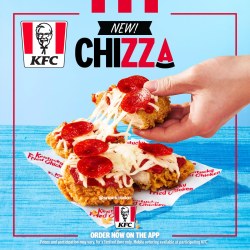
Yes, these are all or were real menu mashups, or seemingly weird food combos. They’re sometimes created as in-and-out promotional items, short-lived monstrosities like the Chizza at KFC, which consists of two (because one would be skimpy) extra crispy (because crispy would be crisp-deficient) chicken fillets, topped like a pizza with marinara sauce, melted mozzarella cheese, and pepperoni (because a single meat-like item wouldn’t be enough). They’re sometimes created as more permanent combinations of two brands, such as Cheez-It or Doritos with Taco Bell.
Ingredient rebranding like the Taco Bell examples is nothing new. National Restaurant News reports that the fast-food favorite will be launching more with greater frequency. They aren’t all major, national brand names, either. Customers at The Border have already enjoyed smaller, regional brands like Austin’s Yellowbird and Southern California’s Truff’s on Nacho Fries, which next will be flavored with Portland’s Secret Aardvark. Tests include Tajín sweet and spicy flavors, Disha Hot sauce packets, Salt & Straw for Ice Cream Chocolate Tacos, and Beekeeper Coffee for a Horchata Cold Brew Latte. And don’t forget Cap’n Crunch delights.
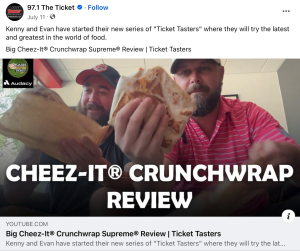
This isn’t merely crazy, fun stuff. There’s strategy behind it — and strategy that’s positioning-based. Taco Bell wants to “Live Más” by partnering with companies that share its values as “cultural rebels” and that will “push us to places we couldn’t get to on our own.” The Cheez-It Crunchwrap took two years to get right. Taco Bell is humble enough to admit that they can learn from smaller companies that have to be more creative. Cultural rebels live more through innovative ideas that stretch the eating and snacking limits. Remember, this is the company that invented “Fourthmeal.”
The strategy behind strangeness.
According to the Food Institute, co-branding is “a powerful tool to pique consumer interest.” Odd and not-so-odd pairings provide “the unique experience for which consumers are looking.” Food brand collaborations create curiosity and help break through the boredom with quick service restaurants (QSR or fast-food chains) and consumer package goods (CPG). But there’s more to it than getting attention via novelty. A HubSpot blog on co-branding outlines the main strategic reasons as expanding a brand’s reach to new customers or new markets; building business by boosting awareness; combining the power of two brands to result in something that’s more than the sum of its parts.
Doritos Locos Tacos took the most boring part of the taco, the shell, and gave it exciting personality by using the signature recipe for Doritos chips to make a new taco shell experience — complete with the magic Doritos dust. The strategy was to attract new customers to both brands. The result was an estimated one billion units in sales during its first year. Another result was reinforcing the Taco Bell brand position as cultural rebels that gives its customers unique ways to “Live Más.” Positionists® should note that the company mantra is not about eating or tasting, but about living more, experiencing more.
According to Natalie Peterson, the VP of Marketing at Icee, “Consumers today say they want to feel like a kid again.” The brand manifested this belief with fun combinations of Icee’s cherry and blue raspberry flavors in a Kellogg’s cereal.
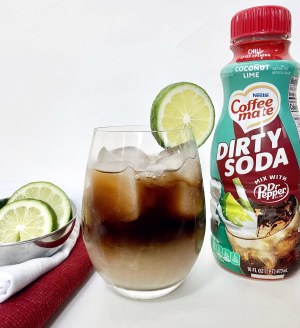
Brands are seeking to appeal to those craving new, unusual flavors both to look innovative and adventurous and to open new sales opportunities as part of their marketing strategies. Some have gone so far as to adding licensing departments to their marketing roster. Hershey’s and Dr. Pepper have been particularly aggressive. The former is demonstrated by Hershey’s ingredients in Betty Crocker products; Yuengling and its Hershey’s Chocolate Porter beer; as well as Ocean Spray dark Hershey’s chocolate-dipped and cherry-infused cranberry bits. The latter has partnered for Dr. Pepper Peeps; adding a special Coffee Mate flavor to Dr. Pepper soda to create Dirty Soda; and Bonne Belle’s Dr. Pepper-flavored lip balm (technically not food unless you make another strange decision).
It’s been called the era of “the brand collab.”
In addition to encouraging consumer curiosity while expanding demographic and category reach, this food brand collaboration strategy ties to trends. People are inventing and sharing their own “weird but delicious” food pairings on social media, with examples including a peanut butter and pickle sandwich, Frosted Flakes with cheese, salami and grapes, melted chocolate on a cheese pizza, and many more stomach-challenging combos. Speaking of which, Combos put peanut butter right inside a hollowed-out thick pretzel, while formerly strange ideas like pizza with pineapple or chocolate-dipped potato chips and pretzels have become mainstream mainstays.
But always keep in mind that, from the perspective of America’s #1 Positioning Ad Agency, we’re not only judging these ideas on taste appeal but also as marketing strategies and how these products impact a brand’s position in the marketplace. With that in mind, what do you think about these, some of which are complementary menu mashups and others which seem more like stunts, some new and others past flavorites?
Ben & Jerry’s + New Belgium Brewing = Salted Caramel Brownie Brown Ale
McDonald’s + Coca Cola = McFloat
New York Chips + Flower City = Bourbon Barrel Malt Vinegar Chips
Oreo + Pillsbury = Oreo Funfetti Chocolate Cake Mix
Talking Rain + Starburst = a line of sparkling ice drinks with Starburst flavors
Goldfish + Frank’s Red Hot = spicy Goldfish crackers
Campbell Soup Company + Frank’s Red Hot = SpaghettiOs Spicy Original
Hidden Valley Ranch + Cheez-It = Cheezy Ranch
Fishwife + JING’S = Sweet & Spicy Zhong canned salmon
Mondelēz + Oreos = Sour Patch Kids Oreos
Going back to the menu at the beginning, The Caviar Company was combined with Kellogg’s to serve caviar on paired flavors of Pringles, then introduced at Coachella. Subsequently, product placement occurred on an episode of “The Real Housewives of New York,” during which the weird combo was served at a party. This was said to be an example of listening to pop culture and giving people what they want.

Whether this is true or not may be beyond the point, as it illustrates another angle to this trend, which is creating new flavors aligned with a celebrity and/or pop culture event. Oreo helped promote a new album by Lady Gaga with limited edition green “stuf” Oreos in a bright pink package. Not to be outdone, the “Barbie” movie inspired Heinz BarbieCue Mayo Barbecue Sauce AND Olipop Barbie Peaches & Cream prebiotic soda.
From a positioning standpoint, the Oreos examples throughout this article point to a process of repositioning the brand as innovative, with new flavors and new ideas far beyond the traditional product, while Heinz has also been going in that direction with flavored ketchups, mayos, barbecue sauces, and Culinary Crunch sauce products. In contrast, the Hidden Valley Ranch brand doesn’t come across as compatible with the adventurous curiosities described here.
The road to excess can sometimes be the road to success.
Note a couple of the sub-trends in these food brand collaborations.
- One is the notion of adding spiciness to familiar flavors, turning up the heat to turn on consumers not satisfied with the ordinary or bland.
- A second is to enhance standard flavors by adding ingredients known for their own signature styles.
- A third is an emphasis on excess. Excess can apply to the amount of food from piled-up food ingredients or to pushing flavor boundaries with intentional weirdness. KFC may be the king of excessive quantity, unfortunately appealing to those drawn to portion sizes not conducive to good health. Along with the aforementioned Chizza, remember the KFC Double Down (a so-called breadless sandwich overly constructed with bacon, two slices of Monterey jack cheese, and sauce, all somehow sandwiched between two entire breaded chicken fillets)? How about the Kentucky Fried Chicken & Donuts or the KFC Cheetos Sandwich?
There was actually a Velveeta Martini kit sold on Goldbelly as a limited edition which sold out almost immediately. Those not risk-averse would infuse vodka with Velveeta cheese sauce to prepare a cocktail garnished with Velveeta Jumbo Shells and rimmed with more Velveeta cheese sauce.
Jones Soda has become famous (to many at least) for their flavor-excess in limited-edition stunt sodas including turkey and gravy, salmon pâté, sweet potato, blue bubblegum, latke, canned ham, and poutine. Thus, the antacid-flavored soda.
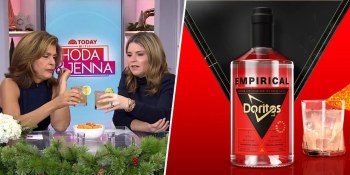
Which means we can finish off the last caviar on a Pringle and the final sip of the Doritos cocktail. That’s the perfect time to reflect on the proliferation of food brand collaborations. Though it’s fun to explore, the marketing strategy makes sense. Companies are shaking up their categories with new experiences, as a clear and overt appeal to younger demographics which are rejecting once-popular restaurant chains and traditional consumable consumer goods.
These new creations satisfy the need for constant, noteworthy content on news and lifestyle websites, but most dramatically are perfect for posting and sharing on social media (e.g., “Look what I had yesterday! Can you believe it?”). Curious and experimental menu mashups may also be consistent with or even reinforce a brand’s position, whether innovative or fun or experiential or as cultural rebels. Others may not, but what harm could a bowl of Frosted Flakes with cheese really do?
If you’d like to try a food brand collab — or apply positioning for more focused marketing of your CPG or QSR brand — our advertising chefs can concoct the right recipe for success. And never fear, our team will go together with yours much better than peanut butter and pickles! Click here to learn more.



